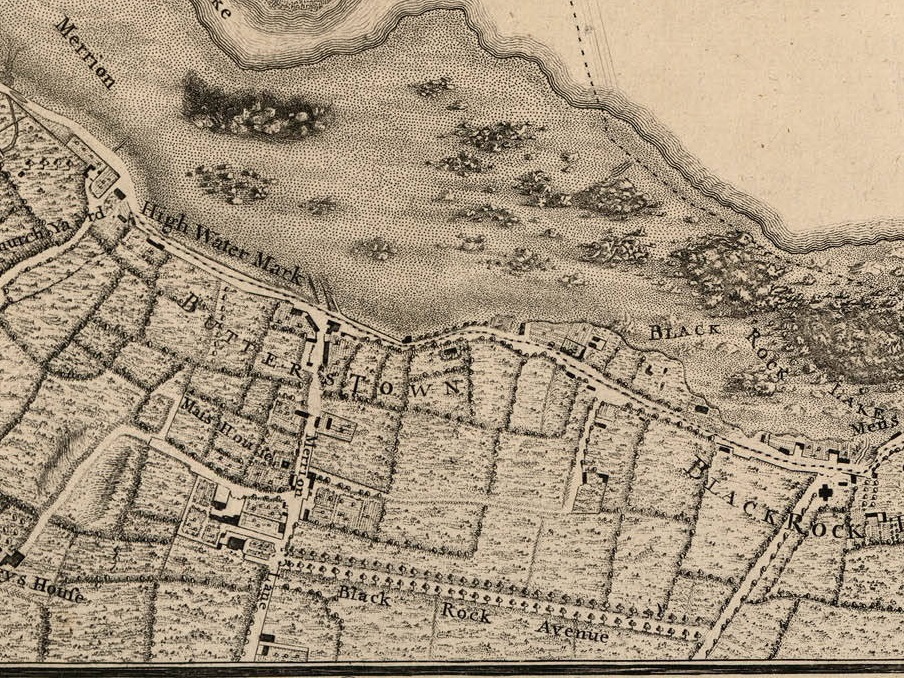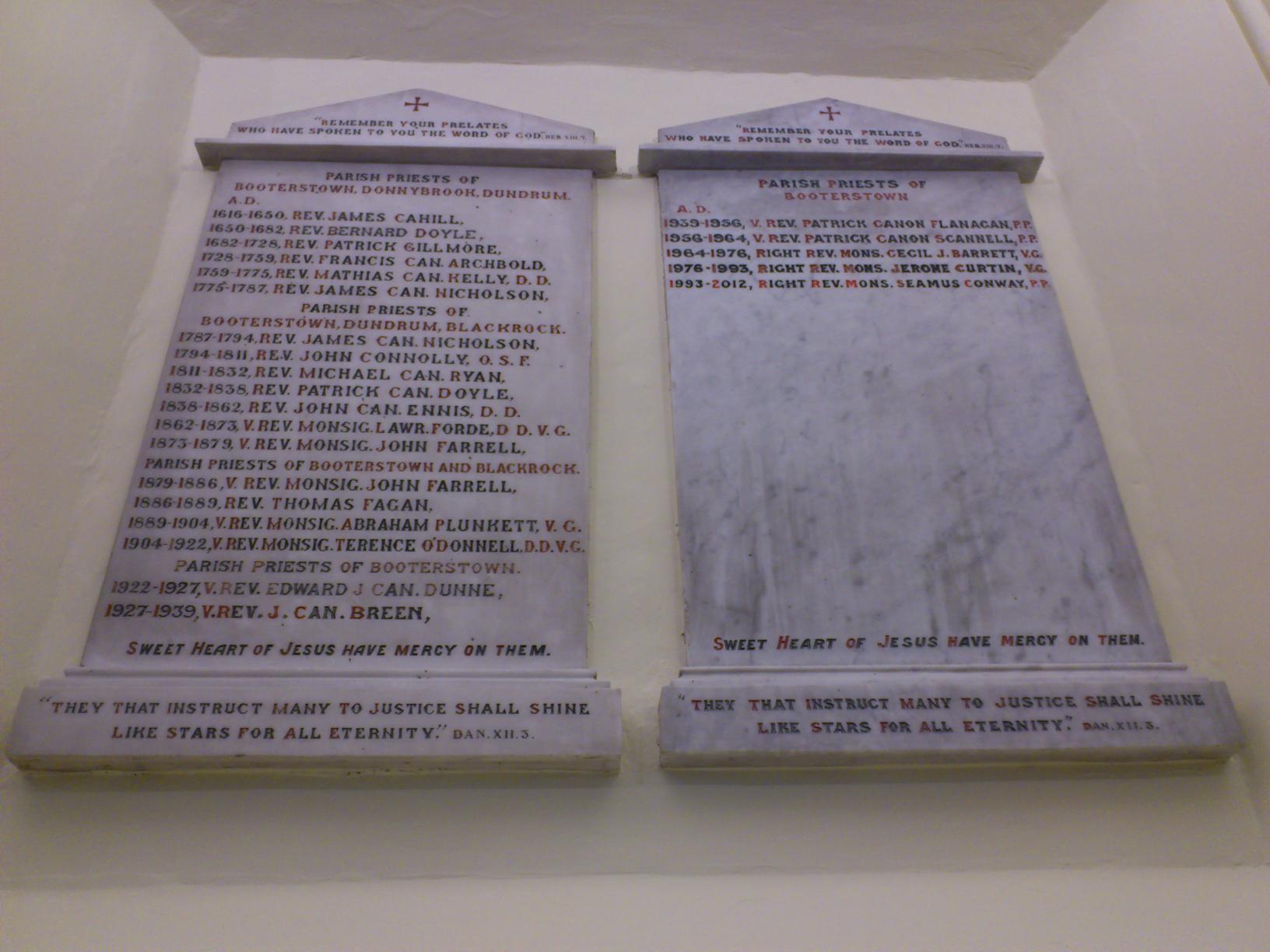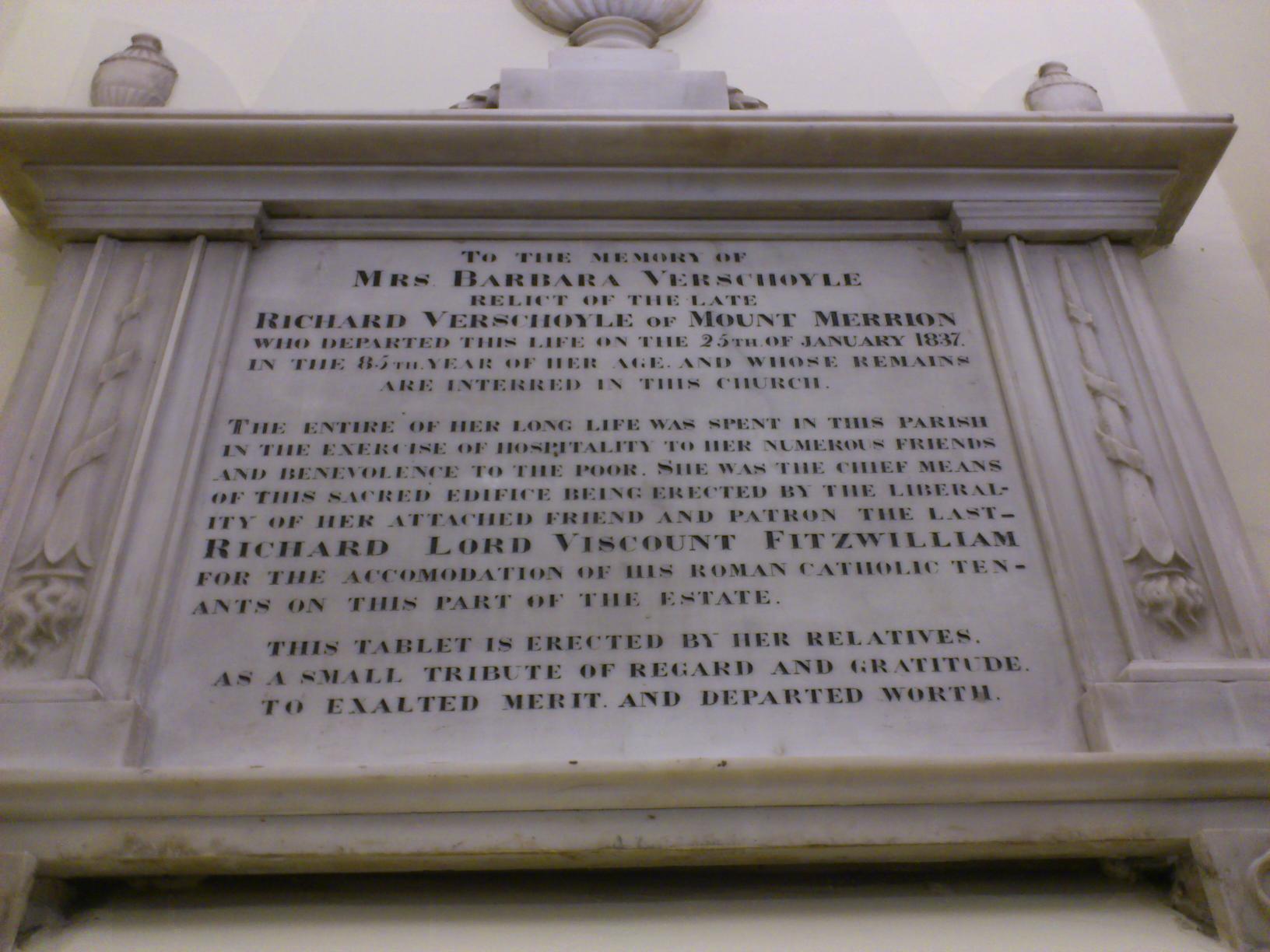Thorn Castle
is now Booterstown and surrounds,
down to Blackrock and up to Mount Merrion.
The Thorn Castle building itself probably stood near Blackrock.
[Ball, vol.2, 1903]
says that in the 18th century
the bridge over the stream at the entrance to Blackrock
(see map)
was called Thorncastle Bridge, and this may be where the old castle stood.
Thorn Castle and Booterstown were
held by
Sir Thomas Fitzwilliam, Kt
in 16th century.
1st Viscount Fitzwilliam
was
cr Baron Fitzwilliam of Thorncastle 1629.
The
grant of Thorncastle, Booterstown and other lands to
2nd Viscount
was
reaffirmed 1666.
In the 18th century
Booterstown Castle
was built into a house
that went for some time by the name "Booterstown Castle"
but was later called "St.Mary's".
Booterstown Castle survives inside "St.Mary's" today.


Part of the parish of Monkstown
in the
[Down Survey, 1655 to 1658].
E (sea) is up.
Booterstown (plot A) is not under the name of Fitzwilliam.
Though grant of it to Fitzwilliam was reaffirmed 1666.
This is part of the larger map of
Kill and Monkstown.
From
TCD.

"Butterstowne" (Booterstown) on
Map of Dublin bay, 1685.
E (sea) is down.
See full size.

Booterstown on
John Rocque's map of Dublin, 1757.
Booterstown Ave is called "Merrion Lane".
Cross Ave is called "Black Rock Avenue".
The lower part of Mount Merrion Ave exists.
(From other maps we know the upper part does not yet exist at this time.)
Note the old Catholic chapel ("Mass House", built 1686) on Booterstown Ave.

Booterstown.
Detail of Pat Roe's map of 1774.
Shows the old Catholic chapel.
See full map.
From Mount Merrion 300.
Used with permission.

Booterstown ("Butterstown")
in
[Taylor and Skinner, 1777].
A plaque on the RHS wall of the current Booterstown church
lists "Rev. James Cahill" as Roman Catholic parish priest of
Booterstown, Donnybrook and Dundrum
from 1616
(in the time of the 1st Viscount)
to 1650.
[Ball, vol.2, 1903]
says that as at 1630, "Rev. John" Cahill was acting as
Roman Catholic priest for
Donnybrook, Ringsend, Irishtown, Booterstown, Blackrock, Stillorgan,
Kilmacud and Dundrum,
under the protection of the Fitzwilliams and the Walshes,
and "was able to perform the services of his church without interference".
[Lyng, 2000]
also has him as "Rev. John" Cahill, says there was no church at this time,
he stayed with the Fitzwilliams
and said mass at Merrion
and Dundrum.
The plaque at Booterstown
shows a continuous line of parish priests from 1616
through the penal years to the present day.
The old Roman Catholic chapel at Booterstown
was built 1686
(in the time of the
4th Viscount),
see
[Lyng, 2000],
making this now one of the oldest
continuous Roman Catholic churches in Ireland.
Although the
5th Viscount
finally conformed in 1710,
the penal laws never really ran in the Fitzwilliam territory of South Dublin.
There is reputed to have been an old mass tunnel
(hiding and escape route for priests)
in the Deer Park
at Mount Merrion.
The Catholic parish register started in 1755
(temp 6th Viscount).
The name "St.Mary's" - The old name for the Booterstown church was "St.Mary's". This might derive as a replacement for the old Donnybrook church "St.Mary's". The Booterstown Castle house was named "St.Mary's", apparently because the parish priest lived there. The site of Merrion Castle is also now "St.Mary's".
Interesting that "Mary" was a family name in the Fitzwilliam family. See:
The present Booterstown Catholic church on Booterstown Ave was built 1812 (on the site of the old chapel) by the 7th Viscount for his Catholic tenants.
The founding of the Catholic Sisters of Mercy convent and school beside Booterstown church in 1838 was contributed to by Sidney Herbert, 1st Baron Herbert of Lea, heir of the Fitzwilliams and frequent resident at Mount Merrion.
The high cross outside Booterstown church was erected c.1868 from a sum of money left to the church by a servant lady from the Pembroke estate.
Canon Patrick Flanagan
was parish priest of Booterstown 1939-56.
The name of Booterstown RC church changed from "St.Mary's"
to the "Church of the Assumption" in 1950.
Richard Humphreys and Deirdre Flanagan
married at Booterstown church in 1965.
See
street view
outside church.


Plaque inside
the Catholic church at Booterstown
(on RHS)
showing the parish priests.
Photo 2013.
See full size.

Plaque inside
the Catholic church at Booterstown
(on LHS)
commemorates its building in 1812 by the
7th Viscount
and his agent
Barbara Verschoyle.
Photo 2013.
See full size
and wider shot.


Pages 7-8 of
the 1826 (posthumous) edition of
Lettres d'Atticus,
written
in French by the
7th Viscount.
This
notes that, although Protestant,
he spent a large sum building a Catholic church at Booterstown for his tenants.
For a full list see
[Lyng, 2000].
So the 17th century
Fitzwilliam protection was ultimately the origin
of just about all of the Catholic churches of
this massive area of SE Co.Dublin,
containing half a million people,
and probably the single most influential area in Ireland.
Please donate to support this site.
I have spent a great deal of time and money on this research.
Research involves travel and many expenses.
Some research "things to do"
are not done for years, because I do not have the money to do them.
Please Donate Here
to support the ongoing research and
to keep this website free.